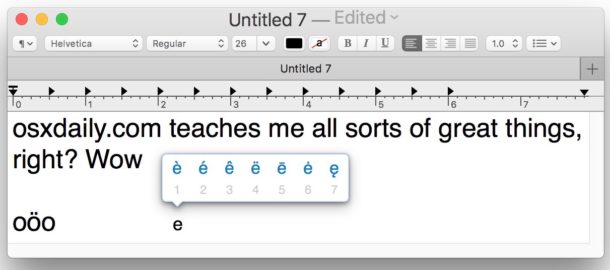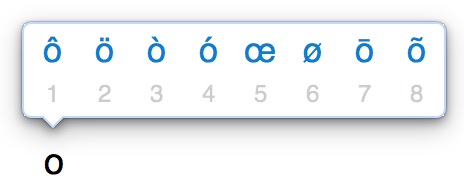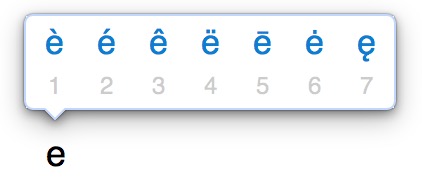How to Type Accents on Mac the Easy Way

Many languages use accents and diacritic marks to change how a letter or vowel sounds. Accordingly, you may find it useful to know how to type accents and diacritical marks on a Mac using the keyboard. This should be particularly useful for users who also type or write in Spanish, Portuguese, French, and Greek, but obviously this applies to many other latin language scripts as well.
Modern versions of Mac OS offer an exceptionally fast way to type letter accents, and it’s quite easy to use.
For typing most accents on Mac you will use either a sustained keypress, or you can use the option / alt key and another modifier key to get the accent or diacritic on the desired letter. Generally speaking you either press and hold the letter to accent, or press and hold the modifier keys, and then you release those keys and then type the letter to be accented. That may sound a little confusing but if you give it a try yourself you’ll see how it works, it’s quite easy once you get the hang of it.
How to Type Accented Characters on Mac the Fast Way
New versions of Mac OS allow users to easily type accented letters and diacritical marks by using a sustained keypress on a single key. For example, if you press and hold on “e” a pop-up will appear after holding that key for a few moments which displays which accents are available for that particular letter or character.
- Press and hold on the letter you wish to accent, continue holding the letter until a menu with character accents are displayed
- Choose the character accent with the mouse, or press the number corresponding below the accent in the menu

You can leave the accent menu on the Mac keyboard by hitting the “ESCAPE” key.
This quick access Accent panel is similar to the fast Emoji typing ability on Mac as it’s accessible from anywhere that you can enter text, whether it’s in Pages, Microsoft Office, TextEdit, a web browser and Facebook, Twitter, or just about anywhere else you’d be typing.
If this accent submenu feature isn’t available to you, it’s likely because you either have a fairly old version of system software, or perhaps you disabled the accent menu to favor key repeat instead. You’d have to reverse that to regain the ability.

If you’d rather see every possible accent and diacritic mark laid out before you, the best solution is to use the special character viewer in Mac OS as described here, which lets you browse all accented latin characters as well as other special characters that are available.
Typing Diacritical Marks and Accents on a Mac Keyboard with Keystrokes
If you don’t want to use the accented character menu option, you can also use accent code key combinations. We’ll show the character, and then demonstrate how to type the accent on a character using the series of key presses necessary on Mac.
Remember, the OPTION key is also the ALT key on a Mac keyboard, it is the same key even if the labeling omits option or alt.
- ó – Acute: Hold down OPTION key and then press “e”, then type the letter you want to accent, like é
- ò – Grave: Hold down OPTION key and then press “`”, then type the letter to accent, like ù
- ô – Circumflex: Hold down OPTION key and then press “i”, then press the letter, like ô
- ñ – Hold down OPTION key and then press “n”, then type the letter, like ñ
- ö – Trema: Hold down OPTION key and then press “u”, then type the letter, like ë
- ç – Cedilla: Hold down OPTION key and then press “c”, like ç or Ç
- ø – Hold down OPTION key and then press “o”, like ø or Ø
- å Å – Hold down OPTION key and then press “a”, like å or Å
- Æ – AE Ligature: Hold down OPTION key and then press “‘” like æ Æ
- œ – OE Ligature: Hold down OPTION key and then press “q”, like œ or Œ
- ¿ – Hold down OPTION key and SHIFT key and then press “?” like ¿
- ¡ – Hold down OPTION key and then press “1”, like ¡
As mentioned before, the other option is to use the Special Character Viewer on the Mac to see all possible options and select a particular accent or special character directly.
Know of another method to type accents on the Mac? Let us know in the comments!


You are brilliant! THANK YOU!!
Thank you!
I’m learning Polish. On my MacbookAir keyboard I can get an e with a tail (ę) but the eight choices with a sustained press on the a do not include the necessary a with a tail (ą). What can I do? (And why is Apple so stupid?)
One thing that I’ve noticed in a newspaper printing setting is that the Windows characters mentioned above do not print out correctly when sent to PDF. They either leave a box or completely short circuit the creation of a PDF.
Do the Mac special characters do the same?
Hello, everytime I have to reboot my new 2017 Macbook Pro High Sierra 10.13.6, the choices for accent dissapears. How can I reactivate it ?
I have a late-2016 Macbook Air using English keyboard, bought in Sweden, and the said technique option/alt + n then n does not produce ñ. Everyone gives this as the technique but it doesn’t work, and for those of us who write in Spanish using the dropdown emoji/symbols menu is not practical. Any other technique known?
What happens if your hold down the n key? Doesn’t ñ show up as the first option?
You can edit the “easy way” accents. I use this to be able to enter the accents for transcribing Chinese in Pinyin with my Danish keyboard. Unfortunately, you have to disable System Integrity Protection (SIP), so you are on your own, but here is what you can do.
Reboot your Mac into Recovery Mode by restarting your computer and holding down Command+R until the Apple logo appears on your screen.
Click Utilities > Terminal. In the Terminal window, type in “csrutil disable” and press Enter.
Restart your Mac. SIP is now disabled.
Copy
/System/Library/Input Methods/PressAndHold.app/Contents/PlugIns/PAH_Extension.appex/Contents/Resources/Keyboard-da.plist
and edit it the way you want.
Move the edited file back:
sudo mv /Users/jens/Documents/keyboard\ for\ pinyin/Keyboard-da.plist /System/Library/Input Methods/PressAndHold.app/Contents/PlugIns/PAH_Extension.appex/Contents/Resources/
and give it the right permissions:
sudo chown -v root:wheel /System/Library/Input Methods/PressAndHold.app/Contents/PlugIns/PAH_Extension.appex/Contents/Resources/Keyboard-da.plist
Reboot your Mac into Recovery Mode by restarting your computer and holding down Command+R until the Apple logo appears on your screen.
Click Utilities > Terminal. In the Terminal window, type in “csrutil enable” and press Enter.
Restart your Mac. SIP is now enabled and you should be able to use the accents that you have edited.
I think an article should published on how to do the accents in iOS. The procedure is similar to the first method described here (the fast way): when the onscreen keyboard pops up, tap and hold on the desired letter and then select the desired accent from the menu. For example to type an á, tap and hold on the a key and, without lifting your finger off the screen, slide it over the menu until á is highlighted in blue. Then simply lift your finger off the screen. Or for ñ, press and hold on n, slide to select ñ and then let go.
All nice ways to get accented letters, and all very slow and incompatible with fast typing. I use the “US International – PC” keyboard, which offers as an added value compatibility with typing on Windows for all of us touch typers.
Basically, you get to your accented letter in two (fast) keystrokes: first you type the “modifier”, then the wovel/letter.
Examples:
‘ + a = á
`+ a = à
‘ + c = ç
” + a = ä
and many others of course, you need to find out with a bit of practice (and the help of keyboard viewer once you have switched to the mentioned keyboard).
This is the only decent way I found (by decent I mean something reasonably fast and not requiring checking the screen) – I hope you will like it.
One of the few annoyances with Macs is the way they handle special characters. The “character map” app that comes with the MacBook is worse than the one for Windows.
In the end, I ended up writing up a Unicode Keyboard in Java. You can move around the Unicode blocks and click on buttons to make strings. Another button copies the output to the clipboard.
Good stuff, but I’m frustrated by the inability of this facility to create an x with a bar on top [of interest to those writing about statistics].
It works well on the iPad too. You hold the key down and the variations show and you pick one.
Note: I found a Czech name with two letters missing from the set: an “r” with the upside down hat and a “u” with a circle over it. I’ve never that “u” before.
It also doesn’t have Turkish ones unless the letter happens to be in a European alphabet (Turkey switched to a Latin based alphabet after WW I).
Note, however, that on iPad after you tap and hold on the letter and the menu appears, you must then slide your finger over the variations without lifting it off the screen in order to be able to select one of them. Once you choose the right one, just lift your finger to type it.
For German Umlaut: press and u, this produces a “, but the cursor does not move, then press a, u or o.
For the German ß (sz) press and s together.
The ° is produced by pressing + + 8 at once.
That’s a good tip!! Obrigado! A hug from Brasília
The suggested methods work fine with Latin-based alphabets but not, for example, for Russian (with the exception of “e”). Having tried lots of approaches to solve the problem, in the end I opted for the “Emoji and Symbols” viewer. There, I’ve set up the “combining acute accent” (Unicode U+0301) as one of my Favorites. When I need to insert an acute accent, I first type the vowel and then insert the acute accent immediately after it. Thus, а́ е́ и́ о́ у́ ы́ э́ ю́ я́. It works equally well for uppercase letters. The same process applies when I need to insert a “combining diaeresis” (Unicode U+0308). Thus, ё.
The German language also uses special letters on the Mac keyboard. For umlaut, hold the Option key and press “u”, followed by “a”, “o” or “u”. For the eszett, hold Option and press “s”. The uppercase eszett (as in SPAẞ FÜR ALLE) is not accessible from the U.S. Mac keyboard, but many fonts include it, and it is accessible from the Emoji & Symbols window.
> The uppercase eszett (as in SPAẞ FÜR ALLE) is not accessible
There is no such thing as an uppercase “ß”. This character is only existing in the lowercase form because no word starts with an “ß”!
Por Portuguese users stuck with a MacBook US keyboard, you can set the keyboard to work similarly to PC keyboards. For example, to type the “á” character, you can type first the ‘ character and then “a”, in order to get the “á” character automatically.
To do this, just set the keyboard layout (under Preferences > Keyboard) to “US International – PC”, under English.
There are other layouts that may work better for each language, but this is the one I find the fastest and easiest for Portuguese users.
You can also type “Option 8 [vowel]” in order to get vowels with acute accents, “Option 9 [vowel] for grave accents.
Also, try Option Shift W|E|R|T|U to get À|È|Ì|Ò|Ù and Option Shift C|V|B|N|M to get Á|É|Í|Ó|Ú
If you’re needing to use Portuguese that often you should add the Portuguese keyboard from the Keyboard prefs menu. When you open the Keyboard prefs you’ll see the list of installed keyboards; click the plus sign and you’ll get a list of all the available keyboards you can install. Scroll through the list to find and select the keyboard you want.